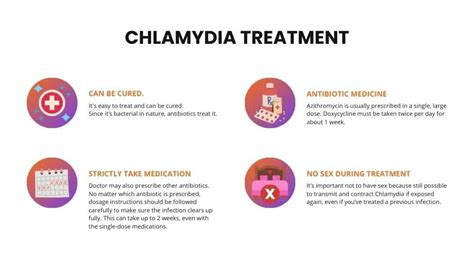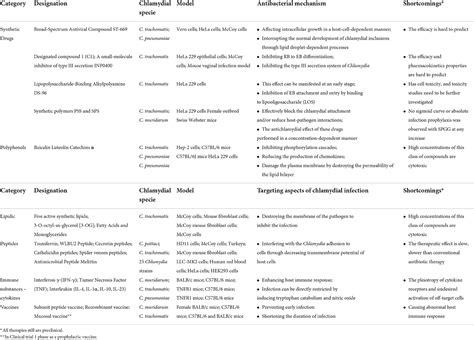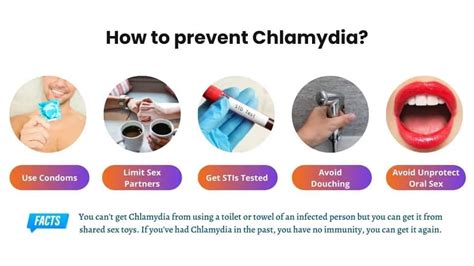Intro
Discover 5 effective ways to treat Chlamydia, a common STD, using antibiotics, natural remedies, and preventive measures to alleviate symptoms and promote recovery, including chlamydia testing and treatment options.
Chlamydia is one of the most common sexually transmitted infections (STIs) worldwide, affecting millions of people each year. It is a bacterial infection caused by Chlamydia trachomatis and can be transmitted through vaginal, anal, or oral sex. If left untreated, chlamydia can lead to serious health complications, including infertility, pelvic inflammatory disease, and increased risk of HIV transmission. Therefore, it is essential to understand the importance of treating chlamydia promptly and effectively.
The good news is that chlamydia is a curable STI, and with the right treatment, it can be completely eliminated from the body. However, it is crucial to seek medical attention as soon as possible to prevent long-term damage and reduce the risk of transmission to others. In this article, we will explore the different ways to treat chlamydia, including antibiotics, alternative therapies, and lifestyle changes.
Chlamydia treatment is not just about taking medication; it also involves adopting healthy habits and making informed decisions about sexual health. By understanding the causes, symptoms, and treatment options for chlamydia, individuals can take control of their health and prevent the spread of this common STI. Whether you are a healthcare provider, a patient, or simply someone interested in learning more about chlamydia, this article will provide you with the information you need to make informed decisions and take action.
Treatment Options for Chlamydia

Chlamydia treatment typically involves a course of antibiotics, which can be taken orally or administered through injection. The most commonly prescribed antibiotics for chlamydia are azithromycin and doxycycline. These medications work by killing the bacteria that cause the infection, thereby eliminating the symptoms and preventing further complications.
Azithromycin Treatment
Azithromycin is a single-dose antibiotic that is often prescribed for chlamydia treatment. It is a convenient and effective option, with a cure rate of over 90%. Azithromycin works by stopping the growth of bacteria, allowing the body's immune system to clear the infection.Doxycycline Treatment
Doxycycline is another commonly prescribed antibiotic for chlamydia treatment. It is typically taken twice a day for 7-10 days, depending on the severity of the infection. Doxycycline works by inhibiting the growth of bacteria, allowing the body to recover from the infection.Alternative Therapies for Chlamydia

While antibiotics are the most effective way to treat chlamydia, some alternative therapies may help alleviate symptoms and support the body's natural healing process. These therapies include:
- Herbal remedies, such as goldenseal and echinacea, which have antibacterial and anti-inflammatory properties
- Homeopathic treatments, such as berberis and cantharis, which can help reduce symptoms and promote healing
- Dietary changes, such as increasing intake of fruits, vegetables, and whole grains, which can help boost the immune system
Herbal Remedies for Chlamydia
Herbal remedies have been used for centuries to treat various health conditions, including STIs like chlamydia. Some herbs, such as goldenseal and echinacea, have antibacterial and anti-inflammatory properties that may help alleviate symptoms and support the body's natural healing process.Homeopathic Treatments for Chlamydia
Homeopathic treatments, such as berberis and cantharis, may also help reduce symptoms and promote healing. These remedies work by stimulating the body's natural defenses and promoting a healthy balance of bacteria in the body.Lifestyle Changes for Chlamydia Prevention

While treatment is essential for curing chlamydia, prevention is key to avoiding the infection altogether. By adopting healthy lifestyle habits and making informed decisions about sexual health, individuals can reduce their risk of contracting chlamydia and other STIs.
Some lifestyle changes that can help prevent chlamydia include:
- Practicing safe sex, such as using condoms and dental dams
- Getting regular STI testing and screenings
- Avoiding multiple sexual partners and reducing the number of new partners
- Avoiding alcohol and drug use, which can increase the risk of STIs
Safe Sex Practices for Chlamydia Prevention
Practicing safe sex is one of the most effective ways to prevent chlamydia and other STIs. This includes using condoms and dental dams during vaginal, anal, and oral sex, as well as getting regular STI testing and screenings.STI Testing and Screenings for Chlamydia Prevention
Regular STI testing and screenings are essential for detecting and treating chlamydia and other STIs. By getting tested regularly, individuals can identify infections early and receive prompt treatment, reducing the risk of long-term complications and transmission to others.Complications of Untreated Chlamydia

If left untreated, chlamydia can lead to serious health complications, including:
- Pelvic inflammatory disease (PID), which can cause infertility and chronic pain
- Increased risk of HIV transmission, as chlamydia can increase the risk of HIV infection
- Reactive arthritis, which can cause joint pain and inflammation
- Proctitis, which can cause inflammation and pain in the rectum
Pelvic Inflammatory Disease (PID) and Chlamydia
PID is a serious complication of untreated chlamydia, which can cause infertility and chronic pain. PID occurs when bacteria from the cervix travel to the upper reproductive tract, causing inflammation and scarring.Increased Risk of HIV Transmission and Chlamydia
Chlamydia can increase the risk of HIV transmission, as the infection can cause inflammation and increase the number of immune cells in the genital area. This can make it easier for HIV to enter the body and cause infection.Conclusion and Next Steps

In conclusion, chlamydia is a common and curable STI that requires prompt and effective treatment. By understanding the causes, symptoms, and treatment options for chlamydia, individuals can take control of their health and prevent the spread of this infection. Whether you are a healthcare provider, a patient, or simply someone interested in learning more about chlamydia, we hope this article has provided you with the information you need to make informed decisions and take action.
If you have any questions or concerns about chlamydia or would like to learn more about this topic, please do not hesitate to comment below. We also invite you to share this article with others who may be interested in learning more about chlamydia and its treatment.
What are the symptoms of chlamydia?
+Chlamydia symptoms can include abnormal vaginal discharge, painful urination, and pelvic pain. However, many people with chlamydia do not experience any symptoms, which is why regular STI testing and screenings are essential.
How is chlamydia treated?
+Chlamydia is typically treated with antibiotics, such as azithromycin and doxycycline. These medications work by killing the bacteria that cause the infection, thereby eliminating the symptoms and preventing further complications.
Can chlamydia be prevented?
+Yes, chlamydia can be prevented by practicing safe sex, such as using condoms and dental dams, and getting regular STI testing and screenings. Avoiding multiple sexual partners and reducing the number of new partners can also help reduce the risk of chlamydia and other STIs.
